Think about this: a tree could be 100, 200, more than 300 feet tall, yet can lift water from deep underground all the way to the leaves of its highest branches. Each day it could move hundreds of gallons, several tons of water this way.
This gravity-defying feat is made possible not so much by the tree but by the properties of water itself.
Trees perform photosynthesis in their leaves, which requires water. The hydrogen in water goes to form carbohydrates—sugar, the food for the tree. The oxygen is exhaled through pores in the leaves.
Water also evaporates, or transpires, through these pores. It’s this transpiration from the leaves that pulls water up the trunk and branches to them.
Now, that’s a long way to lift it, so the water itself helps. Water molecules have properties of both cohesion—they want to stick together—and adhesion—they want to stick to other things.
You can see this in a water droplet on a windowpane: Cohesion holds it together. Adhesion sticks it to the glass.
Water wants to stick to the insides of the tree’s vascular system. And it wants to stay connected in an unbroken column of water, advancing ever upward, until it evaporates from the leaves.
Even if you don’t consider yourself a tree hugger, you can’t help but admire a tree’s incredible natural abilities.
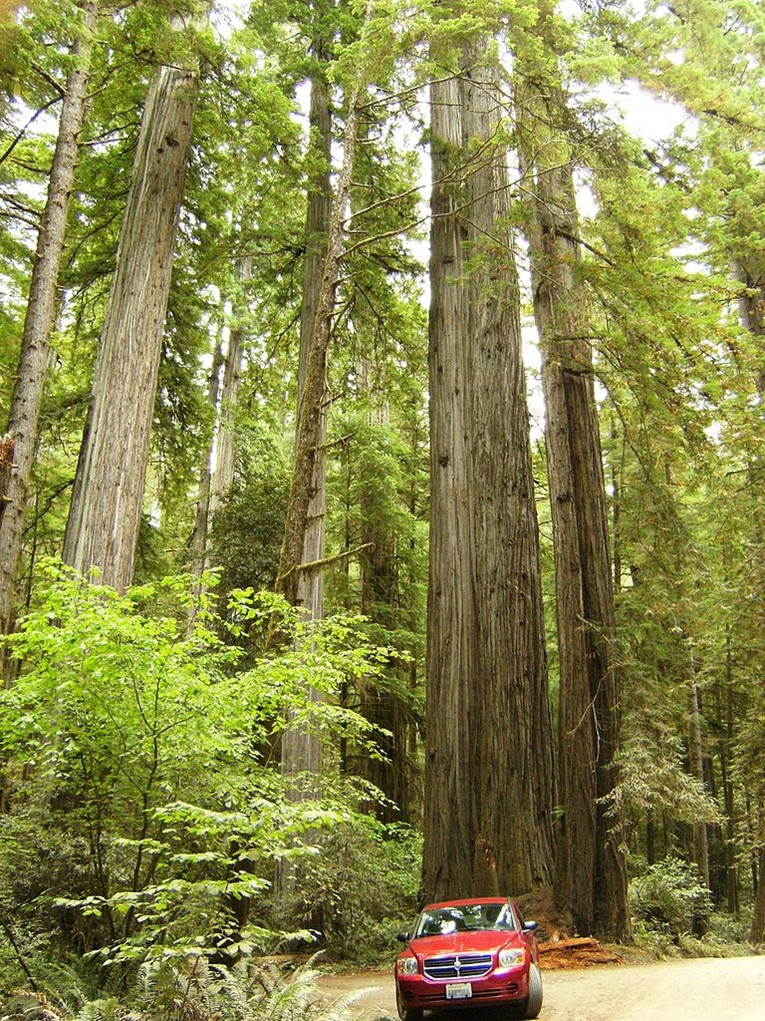
Credit: Theo Crazzolara, via Wikimedia Commons
Background
Synopsis: Trees are an integral part of Earth’s water cycle, defying gravity to draw water upward from soil and bedrock into their canopies. Trees rely on the cohesive properties of water to maintain hydraulic connectivity from the ground to the leaves through micron-thin straw-like conduits in their woody xylem. While leaves combine some of this water with carbon dioxide to produce the sugars trees need for growth, more than 97% evaporates into Earth’s atmosphere in a sunlight-driven process called evapotranspiration. What happens to trees during drought?
- From dogwoods to sequoias, trees produce their food in the photosynthetic factories in their leaves. Since water is half of the ingredient list for photosynthesis, trees must get water up into their leaves to survive.
- Trees obtain most of their water from soil and bedrock via capillary action into their roots. Even when wet, leaves don’t take in much water.
- To move water, trees depend upon two important properties of water related to the polarity of water molecules that makes them want to stick together to form continuous streams: cohesion (water sticks to water) and adhesion (water sticks to other molecules).
- You can see these properties in the surface tension of water droplets that make them rounded and in the tendency of water to climb up the walls of glass beakers to make a meniscus (the curve of the upper surface of a liquid).
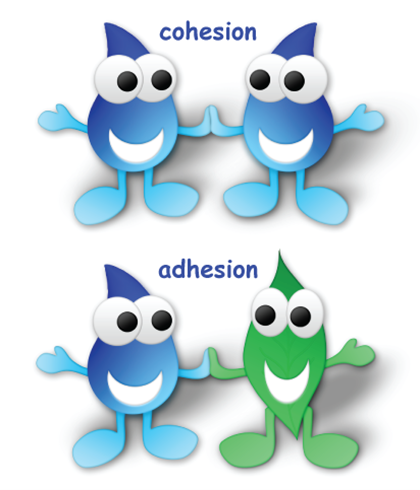
- Trees evolved highly effective vascular systems to move water against the force of gravity into their canopies, characterized by two types of tissue with two purposes.
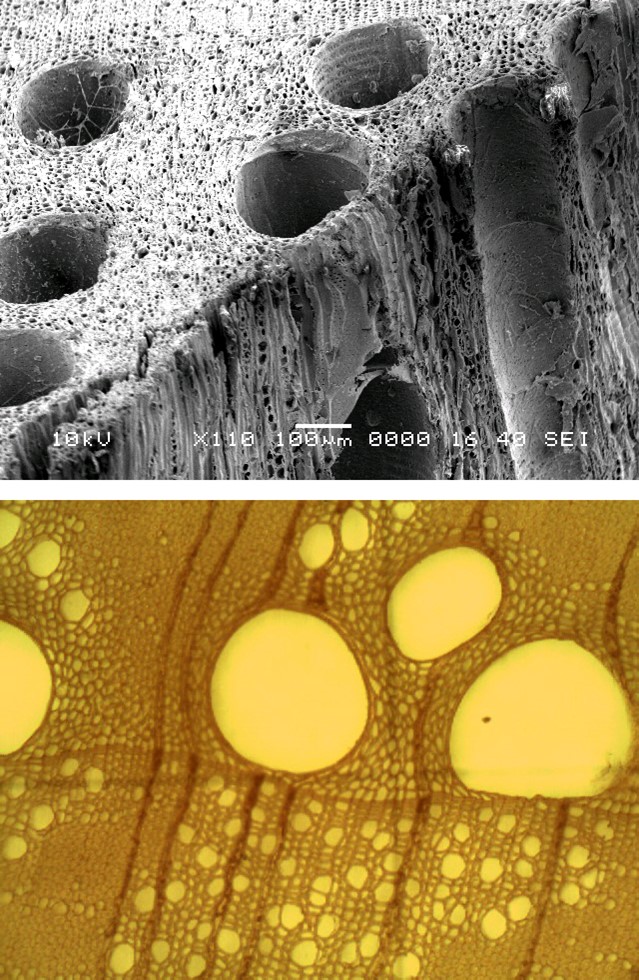
Scanning electron microscope image (top) and transmission light microscope image (bottom) of tracheids in oak xylem.
Credit: McKDandy at English Wikipedia, via Wikimedia Commons- Xylem is the woody part of the tree that gives it structural support. Once the elongated xylem cells have grown, they die but leave behind tiny unidirectional vessels called tracheids that continuously draw water and dissolved nutrients from the roots through the trunk to every branch and leaf of the tree. Every leaf is connected through tracheids to the roots.
- Phloem is made of elongated cells just inside the bark that remain living, creating tiny bidirectional pipelines that distribute nutrients and sugars to areas of the plant that are growing or into the roots in fall for storage over winter.
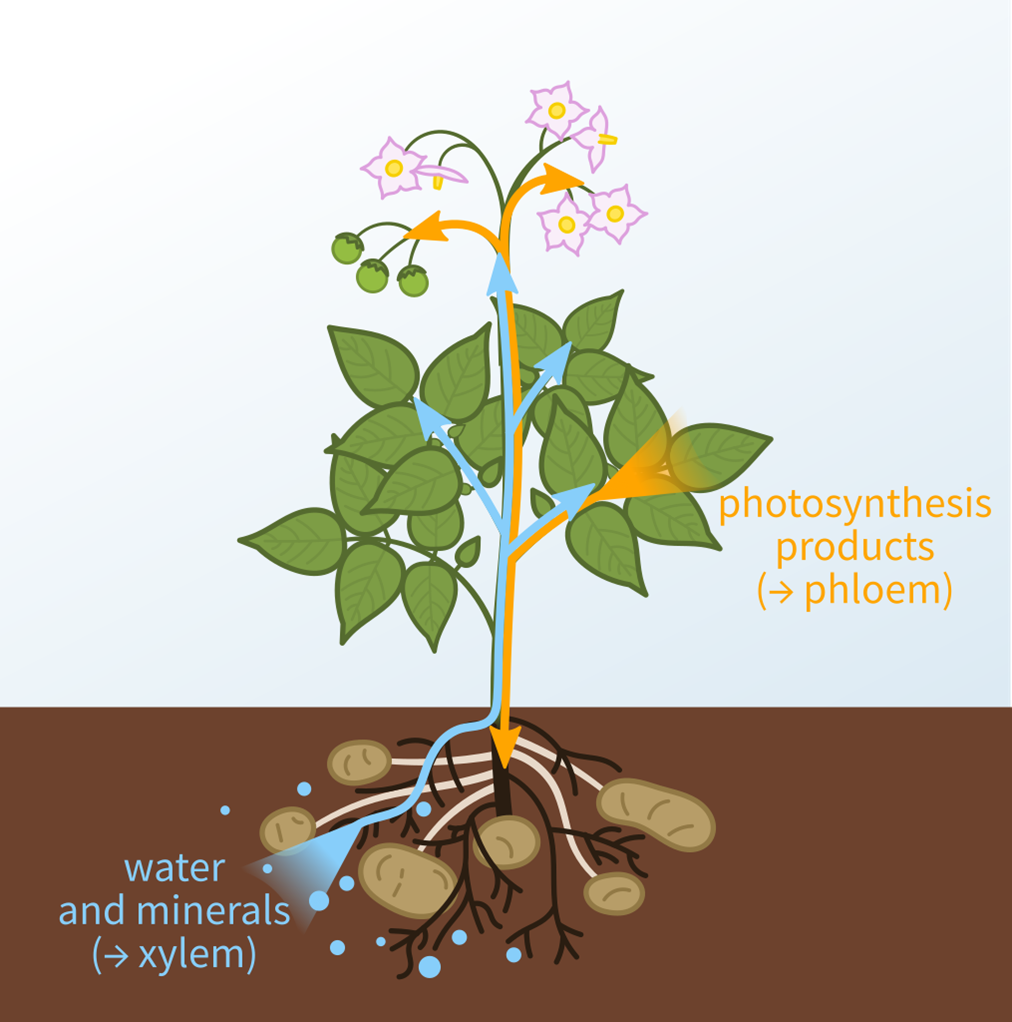
Xylem (blue) carries water one-way from the roots upward while phloem (orange) carries products of photosynthesis to areas where energy is needed for growth. In the autumn sugars are transported to storage organs for redistribution the following spring.
Credit: Nefronus, via Wikimedia Commons - Sunlight and chlorophyll drive the photosynthetic process, with water supplied from below by the xylem and carbon dioxide supplied from above by the atmosphere.
- When exposed to sunlight, leaves open special pores (stomates) to inhale carbon dioxide (CO2).
- The leaves sip water from the straw-like tracheids and combine it with carbon dioxide from the atmosphere (in the presence of chlorophyll) to produce sugars.
- The leaves exhale oxygen (O2) through the open stomates as a waste byproduct.
- As a chemical formula, photosynthesis is 6CO2 + 6H2O + light → C6H12O6 + 6O2.
- In the absence of sunlight, the stomates close, but the water column remains in the tracheid, like holding water in a straw with your fingertip, ready for the next day.
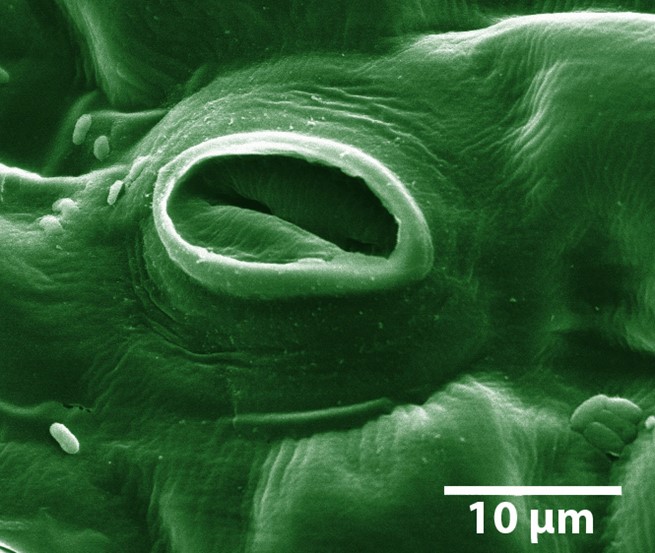
An open tomato leaf stomate. Human hair ranges from 17 micrometers to 181 micrometers, averaging to about 75 micrometers.
Credit: Photohound, public domain, via Wikimedia Commons - While the stomates are open for exchanging CO2 and O2 during photosynthesis, 97–99% of the water transported to the leaves evaporates in a process called transpiration.
- Volumetrically, it can be argued that this high rate of evaporation from the leaves draws the bulk of the water upward from the roots to the canopy.
- Trees replace both the water consumed during photosynthesis and lost through transpiration by imbibing more water at their roots.
- Recent research has shown that many forests transpire much more water vapor than can be sourced from soil moisture alone, indicating that some trees tap directly into bedrock aquifers as an alternate water source.
- Around 10% of water vapor in Earth’s atmosphere comes from transpiration.
- With all this water transport, how do plants adapt in arid regions?
- In arid regions, plants have adapted to prevent water loss through a variety of mechanisms.
- Some decrease water loss through stomates by reducing leaf size, limiting stomates to just the bottom of leaves, or by evolving stomates that only open at night to store carbon dioxide for the next day’s photosynthesis.
- Some drop their leaves in drought and operate photosynthesis using chlorophyll in their bark.
- Others mitigate transpiration losses by developing internal water storage, waxy-coated leaves, or hairy coverings that provide cooling ventilation for the leaves.
- Where water is usually plentiful, plants produce leaves with the largest surface area possible to maximize photosynthesis, but, when plants don’t have time to adapt and evolve in newly evolving drought situations, this may be fatal.
- When humidity is low, low atmospheric vapor pressure increases evaporation from open stomates.
- When temperatures are higher, the atmosphere can hold more water vapor, creating more demand for evaporation through transpiration.
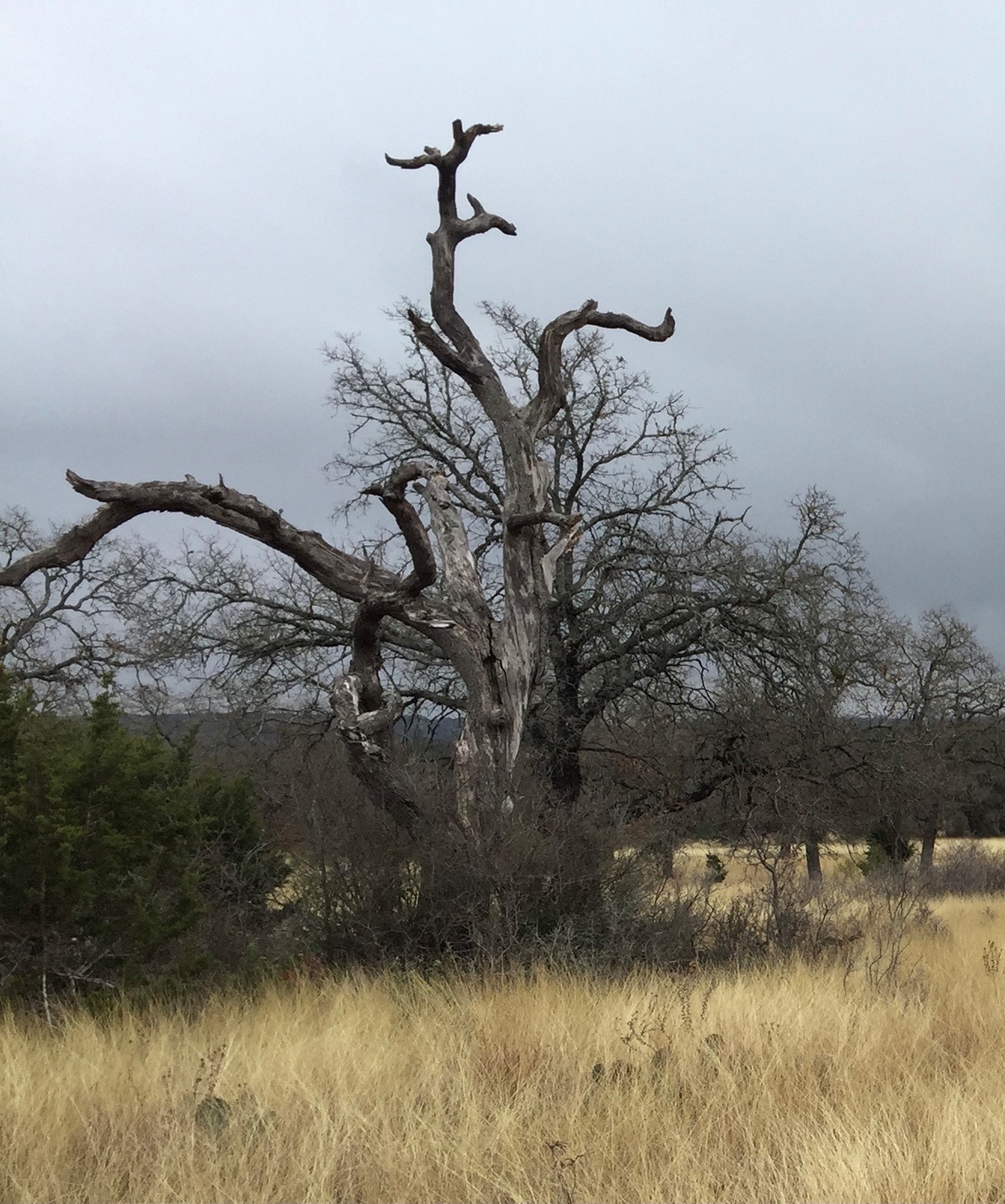
- Trees die of thirst and starvation in drought in three main ways.
- If a tree transpires water too quickly, it may develop xylem air embolisms that break the cohesion of water from roots to leaves, causing hydraulic failure that deprives photosynthetic factories of a water source, which results in the tree drying out.
- Trees may respond by closing their stomates, but this cuts off their access to CO2 for photosynthesis, potentially starving the tree of carbon for photosynthesis leading to tree death unless stored sugars can be accessed.
- If tree roots are detached from their capillary attachment to soil moisture, water transport shuts down, stopping photosynthesis, causing dehydration and die back. This is a good reason for trees to connect into bedrock aquifer water storage for survival.
- Weakened trees are more susceptible to pests, disease and fire.
- Forests benefit their local climates through transpiration, canopy roughness and the production of biogenic aerosols, in addition to consuming carbon dioxide.
- Like sweating, water vapor produced through transpiration cools the forest.
- Uneven forest canopies create turbulence that deflects hot air masses.
- Biogenic volatile organic compounds that are evolved from stomates along with water vapor provide cloud condensation nuclei that reflect sunlight while increasing local cloud coverage and rainfall.
- Forests may be up to 5° cooler than cleared areas, like natural air conditioning.

